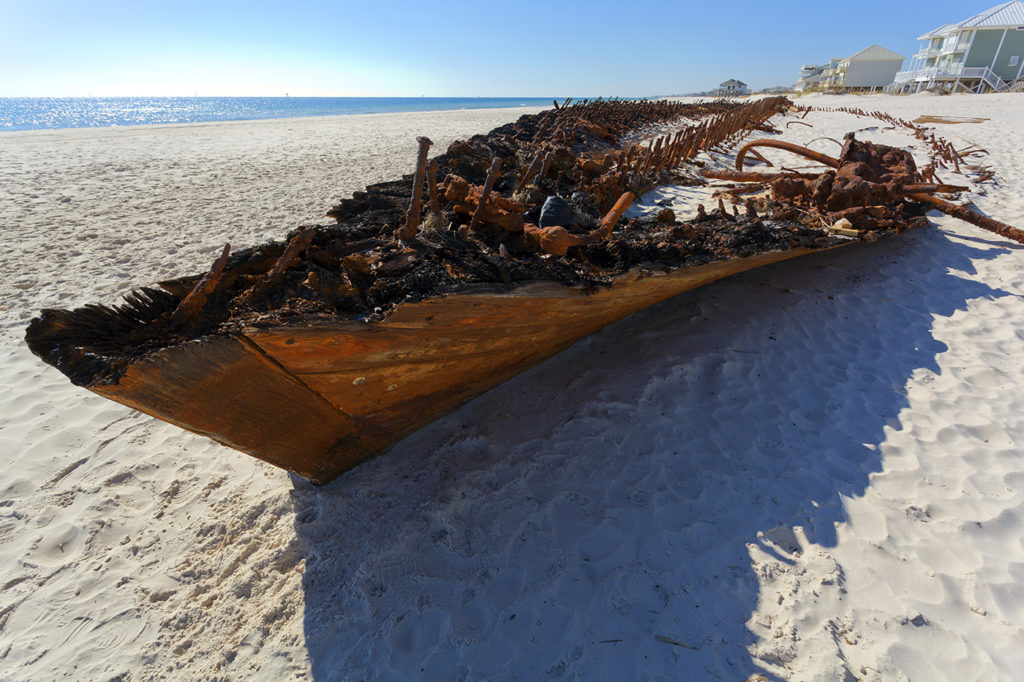
Few things are as intriguing as a wooden shipwreck half-buried in white sand beside emerald waters. Thoughts turn to old salts and peg legs, tall tales and ratlines, exotic ports and loquacious parrots. Alabama’s most famous example, the Rachel, lies five miles east of Fort Morgan between a stilted vacation house and the wrack line, easily visible to beachgoers. This wonderful artifact especially fascinates children and adults from landlocked states. As one Kentuckian told an Associated Press reporter, “We don’t ever see anything like this.”
Speculation as to the vessel’s identity runs the gamut. Was she a pirate ship? A Civil War blockade runner? A rum runner? None of these guesses is unreasonable; all of these vessels are known to have once coursed our shores.
The truth might seem more prosaic — she was an early 20th-century lumber schooner, “like the tractor trailers of today, ” as Mike Bailey, the director at Fort Morgan puts it — but therein lies a compelling tale all its own. To begin with, the Rachel was built not for any practical reason but as an act of filial piety. Captain John Riley Bless McIntosh was a Mississippian with a love of the sea who saved and saved but never achieved his dream of owning a ship. After he died, his daughter, Rachel, took the $100, 000 he’d accumulated to a Moss Point shipbuilder named John De Angelo to fashion a schooner as a memorial. De Angelo was reluctant, knowing the maritime world’s brutal economics, but considering the post-World War I downturn in his business, his sons took the unusual commission. The resulting vessel was large for a three-masted lumber schooner — 155 feet stem to stern and 36 feet in the beam, drawing 12 feet loaded — and looked positively boxy from the stern. Dubbed the Rachel, the completed vessel remained docked, the fees paid by McIntosh’s daughter until her death in 1922. The De Angelo brothers claimed the schooner for expenses shortly thereafter and then sold her at auction.
By late 1923, a man by the name of W.B. Paterson took ownership of the Rachel and hired a Mobile outfit to manage her. This was at the height of the Deep South lumber boom, and in October her new captain and seven-man crew took on a load of yellow pine and made sail for Cuba. They delivered their cargo without incident before heading back home. Rumors that they indulged in a little rum-running could well be true, it being the Prohibition era and Mobile being Mobile, but there is no way to prove it now.
That autumn was a stormy one in the Gulf. As the Rachel sailed north, a massive tropical disturbance extending from Veracruz, Mexico, to the Louisiana coast prompted small-craft warnings as far east as Pensacola. By October 16, the system was rated a minimal hurricane, its center expected to track over Morgan City, Louisiana. For those ashore, the resulting blow ranked as little more than a gusty thunderstorm; New Orleans reported southeast winds of 36 miles an hour; Mobile, 60; Pensacola, 64.
Out on the water, it was a different story. The ships and their crews dotted across the horizon faced the dreaded prospect of a lee shore. In nautical parlance, a lee shore is land toward which the wind is blowing. Ships dependent on sails or low-pressure steam engines that were not far out to sea were likely to be driven aground. Wallowing in the big swells and unable to beat to windward, several vessels including the Rachel were facing serious trouble. On a trip from Tampa to Cuba, the schooner Bluefields was, her captain later reported, “buffeted and battered” for two days before being dashed onto the beach at the Alabama-Florida line. Her crew abandoned ship beforehand, but unfortunately four perished trying to swim ashore. The others made it to the beach exhausted, where they were repeatedly rolled in the surf until able to claw their way to safety, gasping and grateful to be alive.
Further to the west, the Rachel attempted to hold her own by dropping heavy anchors and reducing canvas down to bare poles. One can imagine the terrifying scene — heaving seas, slashing rain, roaring wind, dragging anchors and land ever closer as the small crew cowered on the pitching deck. Being in ballast (without cargo), the Rachel was swept ashore like flotsam and grounded “high and dry.” Happily, her crew remained aboard and was safe.


In the following days, the Rachel’s owner attempted to have her towed off, but she was 40 feet from deep water and so firmly planted that even the big tugs that attempted the task were unable to accomplish it. Resigned to the loss, Paterson had her stripped and filed an insurance claim. Soon enough he collected his settlement and then dismissed the guards he’d hired to protect the vessel. Subsequently, the Rachel was further scavenged by beachcombers and soon burned down to the keel.
And so there she lies to this day, periodically covered and then exposed by shifting sands. Each time her elegantly tapered outline is revealed to the bright Gulf sun, tourists and residents alike gather to marvel at the schooner’s bones. Few of them will ever likely know the real story of the Rachel — the old captain’s dream, the daughter’s homage, the peril of a lee shore or the sailormen’s frantic struggle in the face of an October gale.
John S. Sledge is the author of “The Gulf of Mexico: A Maritime History.”





